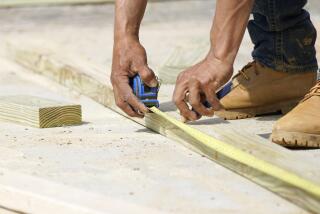Homeowner Can Profit From Fix-Up Facts
- Share via
Question: We bought a fixer-upper several years ago, and because of a shortage of funds we were never able to do some of the things we had in mind when we bought it. Now we are interested in fixing it up and selling it. Naturally, we hope to come out with enough money to make the down payment on a bigger and better house. Can you provide me with some ideas that help to sell a house?
Answer: Real estate experts say a fireplace is one of the best investments in remodeling a house, and it’s relatively easy to add one of the manufactured fireplaces, such as a Heatilator.
A relatively inexpensive and easy-to-install addition are beams in the ceiling of the living room or family room. Of course, I mean false beams that are constructed like boxes, rather than the solid timbers that could cost a small fortune. Beams on the ceiling add a lot of character to an otherwise dismal room.
Devising storage and closet space for an older home can be a selling point.
A Popular Science book published last September can provide you with 36 projects that will enhance your home and the yard and should easily pay for itself when you complete any one of the projects.
Its title is “Do-It-Yourself Projects From Attic to Basement”; the author is Bernard Price (Rodale Press: hardcover, $29.95).
Among the projects are installation of a Whirlpool bath and a sauna, garden lights, automatic garage door, intercom and central vacuum systems.
Q: We bought a nice piece of carpeting at a store that sells remnants. The problem is that the edges aren’t finished, and it has started to fray. I clip the threads periodically, but new frays appear very quickly. Is there something I can do to stop the fraying--short of sending it off to a carpet shop to have the edges bound? Also, there’s a small damaged place in the center that needs to be replaced. How can I do that?
A: Check your hardware store for a carpet adhesive that can be applied to the edges to prevent the fraying. You’ll also need a product such as that--plus a scrap of matching carpet--to repair the damaged area.
On the back of the carpet, coat the area with the carpet adhesive, going a couple of inches beyond the damaged spot. When dry, mark a square or rectangle around the damaged area to be cut from the carpet with a metal straightedge and sharp knife. (A heavy-duty X-acto knife will do this easily.)
Use this removed square as a template (or cutting pattern) for the carpet you will use as a replacement. If there is a pattern in the carpet, you, of course, must match that. Also, you should check to see the direction of the pile of the carpet and match that. (Rub your hand over the carpet to find the direction of the pile.)
After cutting the damaged area out, apply another coat of the carpet adhesive to the back side of the carpet. When dry, cover the back side of the hole with carpet tape, extending it well beyond the hole. Now from the top side, insert the new patch in the hole, pressing it firmly to the carpet tape on the underneath side.
More to Read
Inside the business of entertainment
The Wide Shot brings you news, analysis and insights on everything from streaming wars to production — and what it all means for the future.
You may occasionally receive promotional content from the Los Angeles Times.










